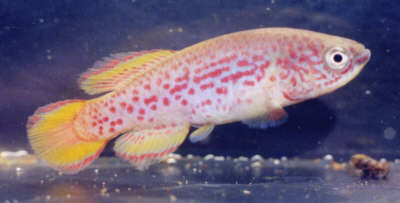| Meaning
of Name |
Pro refers to the latin before. Nothobranchius
is an east African genera. After E.J.(Ted) Seymour.
|
| First
Description |
Loiselle, Paul V. & Blair, David 1971.
A New Species of Aphyosemion
(Teleostomi: Cyprinodontidae: Rivulinae) From Ghana, and a Redefinition
of Subgenus Fundulopanchax Myers,
1924.
JAKA Vol.8 No.1, Winter 1971 / 72.
|
| Size |
Males 34mm SL, females 36·7mm SL.
|
| Meristics |
D = 14-17, A = 15-18, ll = 29-31.
|
| Karyotype |
Males n=9, females n=2.
|
| Sub-Genus |
|
| Group |
|
| Synonyms |
- Aphyosemion
BKA U1
- Aphyosemion seymouri
(Loiselle & Blair 1971)
|
| Populations
|
|
|
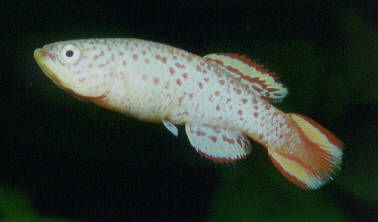
Pronothobranchius seymouri.
Photographed in 1975 from fish received from
the German Democratic Republic.
Photo courtesy of Ed Pürzl
|
|
|
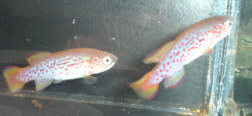
German Import
2001? 2 males.
Photo courtesy of Alan Green.
|
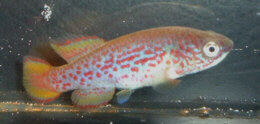
German Import
2001? distributed in Europe.
Photo courtesy of Alan Green.
|
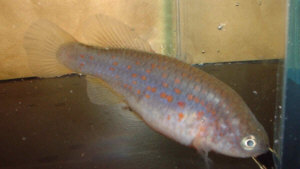
Female of the
German import 2001. This is notably different to the 1968 import
being noticeably spotted on the body.
Photo courtesy of Alan Green
|
BKA Import - The BKA imported
2 shipments. The first on 28th June 1970 from David Blair was distributed
as Aphyosemion BKA U1, collected
55 miles east of Accra. Fish arrived in poor condition with anchor
worm & parasitic infection. All fish were lost but some breeders
managed to get enough eggs to carry them on. Males were very aggressive
to each other.
Some fish were sent to Scheel who considered they should be placed
in Aphyosemion on the basis of
cephalic squamation of egg type.
The 2nd import came on the 10th July 1970, probably collected to the
west of Niamey, the capital of Niger.
In 1970 readings were not taken from the collecting site which was
100 metres long, 4 metres wide & 1·5-10 cms deep. Another
area 2 kms away was measured at water temperature (surface) 26°C
(bottom) 24·5°C, pH 6·8, DH 1. Taken on a cool morning.
Water temperature at 14.30 hrs was a uniform 28·3°C in
8 cm of water.
|
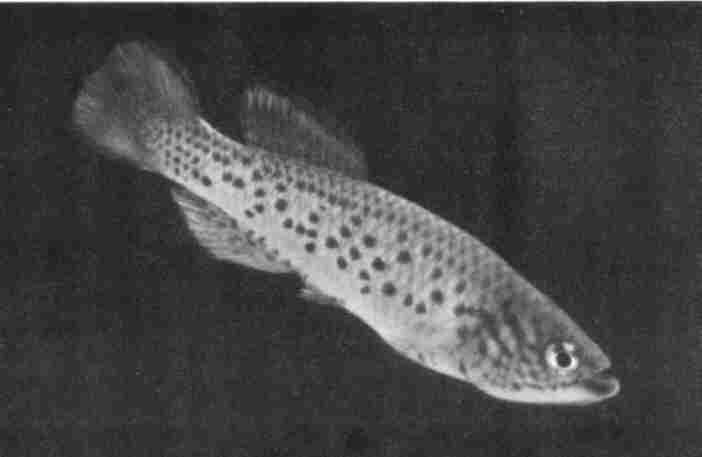
Pronothobranchius
seymouri from a BKA import,
Photo: Bob Heap. BKA
photo from an I/P dated 1972.
|
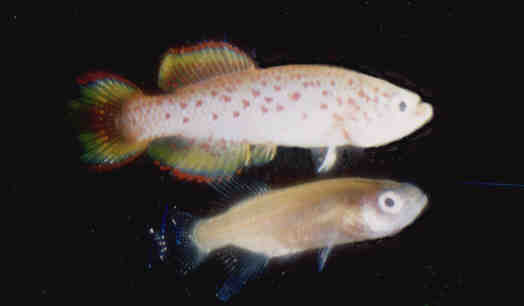
Pronothobranchius
seymouri BKA import 1969/70 (formerly Aphyosemion
BKA U1)
BKA Photo
|
|
| Type
Locality |
Collected 55 miles
southeast of Accra on the Accra - Ada road.
|
| Distribution |
Restricted to Volta River drainage.
Reports have suggested that material is deposited in the American Natural
History Museum being collected in the Central African Republic.
|
| Habitat |
The paper describing A.seymouri
gives details of other aquatic organisms present in the biotope including
water striders, water scorpions, dragonfly & mayfly(?) larvae, 'giant
water bugs' & several sp. of diving beetle some of which were notably
predatory on fish. No mosquito larvae were found in these pools.
In August 1970 isolated pools in this area were checked out & mosquito
larvae were present but no A.seymouri
(P.kiyawensis).
Stomach contents of 6 individuals contained a large part of Cladocereans,
small hemipterans & adult dipterans.
Large dragonfly & predatory diving beetle sp. were observed to attack
fish in a collection seine.
Ghana sp. known to be sympatric include Petersius
intermedius (Characin), Barbus macrops
(young), Barbus atakorensis (young),
Barbus leonensis (young), Hemichromis
bimaculatus, Tilapia guineensis,
Tilapia melanotheron (young &
adults).
Also collected in an intermediate stream in the Shai Hills, 30 miles
north of Accra on the Accra - Akosombo road.
Distribution of this Accra collection would
appear to be concentrated to the west of the Densu River. To the
east the Volta River. South by the coast & north by the Shai
Hills.
David Blair in 1970 & John Hughes
from 1969 onwards have searched for this sp. in the area of Katagum,
Northern Nigeria but have failed to find it.
|
| Distinguishing
Characteristics |
This species
is more heavily spotted than others in the genus. Probably the most commonly
seen in the hobby although they are hard to find. |
| Colour/Pattern
Variability |
Unknown due
to insufficient material from which to study. |
| History |
Ahl described the species in 1928 from one male
& one female collected in the Kiyawa River by Lt. Lloyd near Katagum,
northern Nigeria. This location is found some 125 miles east of Kano.
In 1970 this sp. was collected to
the west of Niamey, the capital of Niger.
In 1974 Scheel placed this sp. in Nothobranchius
in the sub-genus Fundulosoma. In
the years following Fundulosoma
was regarded as a full genus however with one representative - thierryi
Odyk
collected in May 1982 & Rosenstock in November 2006 on the Accra
Plains.
Pinto
collected in 2009 on the Juapong road north of Akosombo.
|
| Breeding
Notes |
The first breeding report for this sp. appeared
in BKA newsletter No.49, September 1969. They were reportedly spawned
on a layer of submerged peat. They were not seen to bury their eggs.
Water used for breeding was pH 6·6, 'trace hardness', temperature
68-73°F.
Another report in newsletter No.51, November 1969 regarded hatching
eggs. The breeder noticed one fry eyed up & trying to get out of
the egg after 37 days of incubation. He wet the peat & the fry,
measuring three eigths of an inch emerged. Four other fry emerged with
a further one trapped by the head in the shell. All fry lay at the base
of the tank & ignored brine shrimp. Despite their size all fry were
lost within 48 hours.
In newsletter No.52, December 1969 a further report on breeding observations
appeared. Scheel reported using water incubation successfully &
hatched out a small number of fry after 6 weeks of incubation.
Another breeder reported using dry incubation varying from 9 weeks to
6 months.
Another breeder reported the fry 'small enough to require infusorians
& stated that even after 5 months many eggs failed to hatch. The
concensus of opinion seemed to favour between 9-12 weeks of dry incubation.
Breeders reported finding eggs just below the surface of the peat but
the majority were well buried.
Roloff gave an account in TFH January 1974 where he reported receiving
a shipment from Blair in 1970. All fish were sick with bloody boils
on the flanks apart from one pair which were healthier. This pair was
selected as brood stock but all others died.
40 eggs were laid in a 2 week period before both fish died.. Eggs were
kept in water at 75°F. Six fry hatched which were all belly sliders.
No data is recorded as to what age in water they hatched at.
Breeding data : water temperature 73 - 78°F, pH 6·5 - 7·5,
DH 8. Eggs maintained at 75°F.
Despite every effort these sliders only
grew to 1" in the biggest case with most being considerably smaller.
At 3 & a half months the fish were set up in a breeding tank with
2" of water over a peat base. Three such spawnings resulted in
20 fry which were healthy & grew to the size of the original import.
There were only 3 females in this brood stock.
Pairs were put into seperate breeding tanks at 4 months of age &
kept together for 1-2 days before being seperated. This was repeated
on a weekly cycle.
Peat was dried for 4 weeks & fry removed with an eyedropper. After
1 day the peat was redried & rewetted in 1 week intervals.
21 spawnings were recorded which produced few fry (12) in an interval
of 4-9 weeks. In 3 cases only 1-2 fry hatched at 11 weeks.
This 4 week incubation was considered unsuccessful & a future experiment
of 6-7 weeks proved the most successful.
None of these fish exceeded 7 months of age.
On a trip to Liberia all his stock was distributed to experienced killie
keepers but after 6 months none survived.
Walter Kessel gave a breeding account in JAKA Vol.9 No.12 reprinted
from a DKG journal where he used a peat based tank, water temperature
72-74°F, pH 6·4 - 7, GH 5 - 15. He found that 90% of eggs
were infertile. Eggs were taken out after 3 days of laying but this
had no effect in getting better eggs.
Roloff suggested a dry incubation period of 6-7 weeks whilst Morgner
tried 8-10 weeks & hatched 28 fry, 18 of which were belly sliders.
The peat was rewet after 10 days which yielded a further 5 fry, 3 of
which were belly sliders. These could not be raised. The peat was redried
to a total dry incubation period of 6 months but all eggs turned white
with no noticeable development.
One breeder we know has kept eggs in dry
storage for 30+ years & has hatched good fry in small batches.
Hans van Es reported variable hatching dates from 3 - 7 months. Generally
eggs should be inspected regularly as hatchings can occur from 4 weeks
to 2 years+.
|
| Diameter
of Egg |
2 mm. Eggs from the original
1968 import to the BKA were reported as being 'clear, pale yellow'.
Eggs I bred from the 2001 German import were red. These being laid in
sand with no peat present.
1· 2mm (Hans van Es - BKA No.330). Egg colour reported as 'yellowish'.
'Once developed they turn very light'. |
| Remarks |
|
